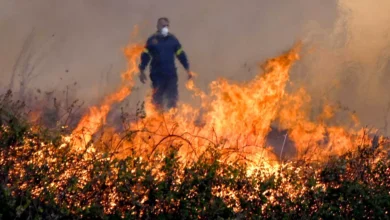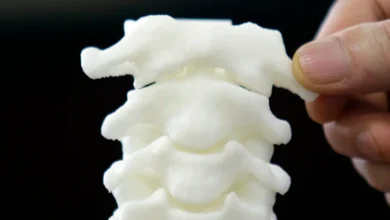Recognising domestic violence as a cause of death: One mother’s long fight

A talented hairdresser with a knack for convincing people to get dressed up in fancy dress for parties, Jessica Laverack (affectionately known as Jessie) was the youngest of three siblings, owned 52 pets at one point, and warmly jostled with her elder sister for their mother, Phyllis’s, attention, even as adults.
In the aftermath of traumatic events, life is often fragmented into “before” and “after”. That was Jessie’s “before”.
During the summer of 2017, Jessie, aged 33, fled more than 50 miles from her home in Rotherham in northern England to escape her ex-partner, after two occasions on which he had strangled her.
It was at this moment that a litany of failings from a supposed safety net of professionals, institutions and organisations started racking up, Phyllis, 68, a retired health visitor from East Riding, says she can see in retrospect.
South Yorkshire Police had attended the scene in Rotherham in May 2017 when Jessie’s former partner first strangled her – rendering her unconscious – but, according to Phyllis, were “treating Jessie as if she was lying” with “clear gaps in their training”. They referred Jessie to an Independent Domestic Violence Adviser, who then actioned a Multi-Agency Risk Assessment Conference (MARAC) – a review by voluntary and statutory organisations in which they discuss high-risk victims of domestic abuse – as standard procedure.
A few days after Jessie’s ex-partner was charged with common assault in May 2017, Jessie told her mother he had attempted to strangle her again. He had been released the morning after being arrested as Jessie had declined to press charges (a common occurrence in domestic abuse cases).
In place of their frightened daughter, Phyllis and her husband, who is also 68 and retired, went to Rotherham Central Police station to report the assault and, after what she sensed was reluctance from staff, was seen by a domestic abuse worker.
“I can remember what it looked like coming up the station, asking the person I was speaking to to record what I was saying, watching them write it down, everything. I had to insist that I wasn’t an overbearing mother and that they take me seriously,” she says.
At this point, Jessie decided to flee, moving to a new address in the northern English town of Beverley.
Unbeknownst to Jessie or her family, the MARAC process was shelved shortly after the initial meeting of organisations took place because Jessie was wrongly flagged as not being registered with a general practitioner (GP) at her new address, and the MARAC neglected to involve or share information with Jessie’s former GP, so nothing could be passed on. This meant there was no longer a record of Jessie being at high risk of domestic abuse on her health records.
Though she can’t be certain, Phyllis believes that her daughter’s ex-partner then tracked Jessie down through bank statements listing her new address, after Jessie pleaded with bank staff to let her close the joint account she had with her ex-partner, according to Phyllis, without his permission. Although Jessie successfully took her own name off of the account, staff still applied her new address to the joint account documents. He began approaching her just months after she had fled, in late 2017.
Housebound by fear in Beverley, while self-medicating with alcohol and suffering from night terrors, Jessie reported to Humberside Police, both in person with her parents and on the phone on at least four occasions, that she was being stalked, harassed and living in fear, all at the hands of her ex-partner. But nothing was done.
Jessie was too frightened to answer phone calls from unknown numbers or attend appointments, which meant she had been removed from her support worker’s caseload before she fled, who had been appointed to her via her Rotherham GP to help with her anxiety. By the time Jessie moved to Beverley, she was increasingly using alcohol as a crutch and, because GPs can’t refer people to alcohol services, she had to attend a drop-in centre to receive support.
Without any trauma-informed alternatives and despite Jessie’s increasing agoraphobia as a result of her terror that her ex-partner might be waiting outside her new house, East Riding Partnerships Addiction Services told her that if she didn’t attend the drop-in, she wouldn’t be allocated a rehabilitation course with East Riding Adult Services. Too frightened to leave the house by herself for fear her ex-partner was waiting for her, Jessie’s mother was forced to wait at the drop-in centre for an appointment to come up, race back to the house to collect Jessie, and then return to the centre for the appointment.
In late 2017, Jessie attended the accident and emergency department at the hospital with her mother, feeling suicidal and having self-harmed. Despite this, her case was not referred back to MARAC, and her self-harm was recorded as “accidental”, even though her mother says she informed staff that she had recently fled domestic abuse. Instead of any type of formal support, the parting comment from staff was that Jessie was “lucky” to have a family who could help her.
‘No one looked at the whole picture’
One in eight female suicides or suicide attempts occur as a direct result of domestic violence or abuse, according to the Women and Equality Unit of the United Kingdom’s Office for National Statistics (PDF), while recent data from the National Police Chiefs’ Council (PDF) shows that increasing numbers of domestic abuse victims end up taking their own lives. In four out of five cases where they do, the abuser was already known to the police.
While the far-reaching impact of the domestic abuse inflicted on Jessie was not accorded the weight it deserved while she was still alive, say her parents, myriad barriers and a poor understanding of the issues only seem to worsen after the death of a victim.
“It was one after the other – it’s like no one looked at the whole picture and saw that she’d been abused. It was just written off as suicide – from the post-mortem to the death certificate, there was no mention of the bruises on her or previous abuse,” Phyllis says.
Death certificate reforms only now coming into force across England and Wales will mean that an independent review will need to be carried out for all deaths, without exception, either by a medical examiner or coroner. If this had been implemented sooner, the domestic abuse Jessie suffered might have been recognised in her death, at the very least, and could have changed her death certificate.
As a result of her experience, Phyllis believes there is no clear pathway for families to obtain justice, and those who do take it upon themselves to try to find justice are met with inaccessible jargon and red tape.
“Life just wasn’t the same, and yet I was having to navigate this really complex system,” says Phyllis. “Night after night, I was researching, learning what words I was supposed to use, what words they used to me and what they meant. All these other people have a top legal team. Police do, health do. Yet they expect a grieving mum to be able to challenge them.”
As far as the police were concerned, it was cut and dried: a straightforward suicide. “Because she took her own life, it was classified as she had a choice, but living a life of domestic abuse isn’t a choice,” says Phyllis.
A few months after Jessie’s death, an inquest was set to take place to determine the cause. But with so many unanswered questions and Jessie’s abuser being the last known person to have been with her, Phyllis appealed to the coroner, who agreed that it should be delayed until Humberside Police investigated Phyllis’s concerns.
It took Phyllis five months to get Humberside Police to agree to investigate the role that domestic abuse had played in Jessie’s death through a Domestic Homicide Review (DHR) (soon to be renamed the Domestic Abuse-Related Death Review, after calls to recognise the role of domestic abuse), after continuous requests.










